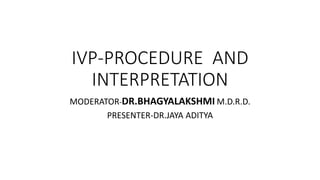
IVP.pptx
- 2. • Radiographic examination of urinary tract including renal parenchyma, calyces and pelvis after intravenous injection of contrast media.
- 3. INDICATIONS • IN ADULTS • Screening of entire urinary tract • Diseases of renal collecting system • Abnormalities of the ureter • Obstructive uropathy • Calculus disease • Suspected renal injury • Prior to surgery of urinary tract • Renal colic • IN CHILDREN • VATER anomalies • Polycystic disease, PUJ obstruction • Urinary tract infection • Malformation of genitalia • Ectopically inserted ureter in girls • Anorectal anomalies • history of • Recurrent urinary tract infection
- 4. CONTRAINDICATIONS • Iodine sensitivity. • Pregnancy • Severe history of anaphylaxis previously
- 5. RISK FACTORS • Cardiac failure • Dehydration • Diabetes with Azotemia • Previous allergic reaction • History of Pheochromocytoma
- 7. Mode of injection • IV. bolus injection • Within 30-60 sec. • Density of the nephrogram is directly proportional to the plasma concentration of contrast media. • Large doses of contrast media increase diuresis distends the collecting system increasing the diagnostic information from the urogram
- 8. PREPARATION- For Adults • Fasting for 4 hours • Do not dehydrate • Bowel preparation: Low residue diet • Bowel wash is given till bowel is clear of faecal • matter Laxative is recommended
- 9. For Children- • Dehydration is strictly prohibited in children. • Colon should be empty-Suppositories are better than laxatives • must not have a full stomach-to avoid vomiting
- 10. PROCEDURE • Patient is placed in supine position-pelvis at cathode side • Reduce lordotic curvature of lumbosacral spine • A scout film is taken • Test injection of 1ml of contrast is given and patient is observed for 1 min to look for any contrast reactions. • Rest of the contrast is rapidly injected within 30-60 seconds. • All films are taken in full expiratory phase only.
- 11. • Cortical nephrogram is seen within 20 seconds. • The nephrogram is made up of 2 phases- 1) Cortical phase- Vascular filling 2) tubular phase- Contrast within the lumen of renal tubule • The appearance of pyelogram is seen 2 minutes.
- 12. • In children- • In neonates- concentrating ability of the kidney is not fully developed • First film is taken 15 min after • Minimum number of films should be taken. • Gonadal protective shields should be used. • Bowel gas paddle compression technique should be used or prone position.
- 13. FILMING TECHNIQUE • Low KV (65-75) high mA (600-1000). • Plain X-ray KUB /Scout film- • Calculus • Intestinal abnormalities • Intestinal gas pattern • Calcification • Abdominal mass • Foreign body
- 14. • After the scout film, 1minute, 5, 10, 15, 35 and post void films are taken. • 1 minute film shows nephrogram. • 5 minute film shows nephrogram, renal pelvis, upper part of ureter. • Compression band is now applied balloon is positioned on anterior superior iliac spine where ureters cross pelvic brim. Better pelvicalyceal distension
- 15. • After compresson is applied, 10 minute film is taken. • demonstrate distended collecting system and proximal ureters. • 15 minute film- prone position,for better visualisation of ureter. • 35 minute film: kidney, ureter, bladder. • Post void film: 1. Residual urine; • 2. Bladder mucosa! lesions; • 3. Diverticula; • 4. Bladder tumour; • 5. Outlet obstruction; • 6. VUR.
- 16. • Delayed films- taken 1-24 hours after injection • Taken at 1 hr, 3hrs, 6 hrs, 12 hrs and 24 hrs. • Used in- 1) Obstruction- Early nephrogram is seen but collecting system is not seen. 2)Long standing hydronephrosis- renal parenchyma is seen but collecting system. • 3) Congenital lesions- Non-visualised upper calyceal system with ectopic
- 17. Filming in Children • Films are taken at 2min. (supine) and 7 min. (prone) after contrast administration. • Carbonated beverage- Improve visualisation of left kidney. • 15-20 degree caudal tilt- Right kidney can be well seen through the liver • In neonates- Excretion of contrast media is delayed
- 37. COMPLICATIONS • Due to Contrast • IMMEDIATE- Minor reactions • Intermediate reactions • Severe reactions • Due to Technique • Upper arm or shoulder pain. • Extravasation of contrast at the injection site.
- 38. Initial treatment • Elevation of affected extremity Ice packs • Close observation for 2-4 hours • Local injection of hyaluronidase
- 39. AFTER CARE • Observation for 6 hours. • Watch for late contrast reactions. • Prevention of dehydration. • In high risk patients-renal function tests should be done to watch for deterioration
- 40. THANK YOU
Notas do Editor
- IVU is the gold standard Malformation of genitalia like bilateral cryptorchidism, III degree hypospadiasis
- 30% risk osimilar reaction on a subsequent occasion. The risk is lower with low osmolar contrast media.
- More iodine increases the density of the nephrogram.
- Dulcolax (Biscodyl) is given 2-4 tablets at bedtime for 2 days prior Castor oil
- Compliance in their administration by parents is erratic. About vomiting-child should not be given anything by mouth for 3-4 hours prior
- -support is placed under patient's knees -including the kidneys, ureters, bladder and urethral regions
- (contrast in calyces)
- as it displaces bowel away from the kidneys.
- As they fill better
- due to immaturity of the tissue
- (15-60 minute applications three times per day for 1-3 days). (if volume exceeds 5 ml).